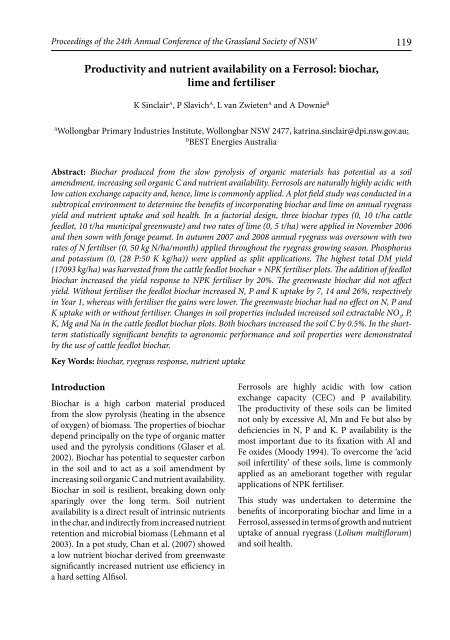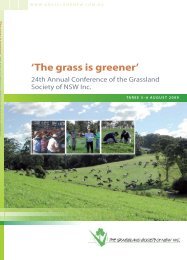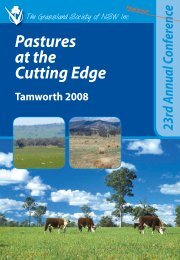Productivity and nutrient availability on a Ferrosol - Grassland ...
Productivity and nutrient availability on a Ferrosol - Grassland ...
Productivity and nutrient availability on a Ferrosol - Grassland ...
Create successful ePaper yourself
Turn your PDF publications into a flip-book with our unique Google optimized e-Paper software.
Proceedings of the 24th Annual C<strong>on</strong>ference of the Grassl<str<strong>on</strong>g>and</str<strong>on</strong>g> Society of NSW 119<br />
<str<strong>on</strong>g>Productivity</str<strong>on</strong>g> <str<strong>on</strong>g>and</str<strong>on</strong>g> <str<strong>on</strong>g>nutrient</str<strong>on</strong>g> <str<strong>on</strong>g>availability</str<strong>on</strong>g> <strong>on</strong> a <strong>Ferrosol</strong>: biochar,<br />
lime <str<strong>on</strong>g>and</str<strong>on</strong>g> fertiliser<br />
K Sinclair A , P Slavich A , L van Zwieten A <str<strong>on</strong>g>and</str<strong>on</strong>g> A Downie B<br />
A<br />
Woll<strong>on</strong>gbar Primary Industries Institute, Woll<strong>on</strong>gbar NSW 2477, katrina.sinclair@dpi.nsw.gov.au;<br />
B<br />
BEST Energies Australia<br />
Abstract: Biochar produced from the slow pyrolysis of organic materials has potential as a soil<br />
amendment, increasing soil organic C <str<strong>on</strong>g>and</str<strong>on</strong>g> <str<strong>on</strong>g>nutrient</str<strong>on</strong>g> <str<strong>on</strong>g>availability</str<strong>on</strong>g>. <strong>Ferrosol</strong>s are naturally highly acidic with<br />
low cati<strong>on</strong> exchange capacity <str<strong>on</strong>g>and</str<strong>on</strong>g>, hence, lime is comm<strong>on</strong>ly applied. A plot field study was c<strong>on</strong>ducted in a<br />
subtropical envir<strong>on</strong>ment to determine the benefits of incorporating biochar <str<strong>on</strong>g>and</str<strong>on</strong>g> lime <strong>on</strong> annual ryegrass<br />
yield <str<strong>on</strong>g>and</str<strong>on</strong>g> <str<strong>on</strong>g>nutrient</str<strong>on</strong>g> uptake <str<strong>on</strong>g>and</str<strong>on</strong>g> soil health. In a factorial design, three biochar types (0, 10 t/ha cattle<br />
feedlot, 10 t/ha municipal greenwaste) <str<strong>on</strong>g>and</str<strong>on</strong>g> two rates of lime (0, 5 t/ha) were applied in November 2006<br />
<str<strong>on</strong>g>and</str<strong>on</strong>g> then sown with forage peanut. In autumn 2007 <str<strong>on</strong>g>and</str<strong>on</strong>g> 2008 annual ryegrass was oversown with two<br />
rates of N fertiliser (0, 50 kg N/ha/m<strong>on</strong>th) applied throughout the ryegrass growing seas<strong>on</strong>. Phosphorus<br />
<str<strong>on</strong>g>and</str<strong>on</strong>g> potassium (0, (28 P:50 K kg/ha)) were applied as split applicati<strong>on</strong>s. The highest total DM yield<br />
(17093 kg/ha) was harvested from the cattle feedlot biochar + NPK fertiliser plots. The additi<strong>on</strong> of feedlot<br />
biochar increased the yield resp<strong>on</strong>se to NPK fertiliser by 20%. The greenwaste biochar did not affect<br />
yield. Without fertiliser the feedlot biochar increased N, P <str<strong>on</strong>g>and</str<strong>on</strong>g> K uptake by 7, 14 <str<strong>on</strong>g>and</str<strong>on</strong>g> 26%, respectively<br />
in Year 1, whereas with fertiliser the gains were lower. The greenwaste biochar had no effect <strong>on</strong> N, P <str<strong>on</strong>g>and</str<strong>on</strong>g><br />
K uptake with or without fertiliser. Changes in soil properties included increased soil extractable NO 3<br />
, P,<br />
K, Mg <str<strong>on</strong>g>and</str<strong>on</strong>g> Na in the cattle feedlot biochar plots. Both biochars increased the soil C by 0.5%. In the shortterm<br />
statistically significant benefits to agr<strong>on</strong>omic performance <str<strong>on</strong>g>and</str<strong>on</strong>g> soil properties were dem<strong>on</strong>strated<br />
by the use of cattle feedlot biochar.<br />
Key Words: biochar, ryegrass resp<strong>on</strong>se, <str<strong>on</strong>g>nutrient</str<strong>on</strong>g> uptake<br />
Introducti<strong>on</strong><br />
Biochar is a high carb<strong>on</strong> material produced<br />
from the slow pyrolysis (heating in the absence<br />
of oxygen) of biomass. The properties of biochar<br />
depend principally <strong>on</strong> the type of organic matter<br />
used <str<strong>on</strong>g>and</str<strong>on</strong>g> the pyrolysis c<strong>on</strong>diti<strong>on</strong>s (Glaser et al.<br />
2002). Biochar has potential to sequester carb<strong>on</strong><br />
in the soil <str<strong>on</strong>g>and</str<strong>on</strong>g> to act as a soil amendment by<br />
increasing soil organic C <str<strong>on</strong>g>and</str<strong>on</strong>g> <str<strong>on</strong>g>nutrient</str<strong>on</strong>g> <str<strong>on</strong>g>availability</str<strong>on</strong>g>.<br />
Biochar in soil is resilient, breaking down <strong>on</strong>ly<br />
sparingly over the l<strong>on</strong>g term. Soil <str<strong>on</strong>g>nutrient</str<strong>on</strong>g><br />
<str<strong>on</strong>g>availability</str<strong>on</strong>g> is a direct result of intrinsic <str<strong>on</strong>g>nutrient</str<strong>on</strong>g>s<br />
in the char, <str<strong>on</strong>g>and</str<strong>on</strong>g> indirectly from increased <str<strong>on</strong>g>nutrient</str<strong>on</strong>g><br />
retenti<strong>on</strong> <str<strong>on</strong>g>and</str<strong>on</strong>g> microbial biomass (Lehmann et al<br />
2003). In a pot study, Chan et al. (2007) showed<br />
a low <str<strong>on</strong>g>nutrient</str<strong>on</strong>g> biochar derived from greenwaste<br />
significantly increased <str<strong>on</strong>g>nutrient</str<strong>on</strong>g> use efficiency in<br />
a hard setting Alfisol.<br />
<strong>Ferrosol</strong>s are highly acidic with low cati<strong>on</strong><br />
exchange capacity (CEC) <str<strong>on</strong>g>and</str<strong>on</strong>g> P <str<strong>on</strong>g>availability</str<strong>on</strong>g>.<br />
The productivity of these soils can be limited<br />
not <strong>on</strong>ly by excessive Al, Mn <str<strong>on</strong>g>and</str<strong>on</strong>g> Fe but also by<br />
deficiencies in N, P <str<strong>on</strong>g>and</str<strong>on</strong>g> K. P <str<strong>on</strong>g>availability</str<strong>on</strong>g> is the<br />
most important due to its fixati<strong>on</strong> with Al <str<strong>on</strong>g>and</str<strong>on</strong>g><br />
Fe oxides (Moody 1994). To overcome the ‘acid<br />
soil infertility’ of these soils, lime is comm<strong>on</strong>ly<br />
applied as an ameliorant together with regular<br />
applicati<strong>on</strong>s of NPK fertiliser.<br />
This study was undertaken to determine the<br />
benefits of incorporating biochar <str<strong>on</strong>g>and</str<strong>on</strong>g> lime in a<br />
<strong>Ferrosol</strong>, assessed in terms of growth <str<strong>on</strong>g>and</str<strong>on</strong>g> <str<strong>on</strong>g>nutrient</str<strong>on</strong>g><br />
uptake of annual ryegrass (Lolium multiflorum)<br />
<str<strong>on</strong>g>and</str<strong>on</strong>g> soil health.
120<br />
Proceedings of the 24th Annual C<strong>on</strong>ference of the Grassl<str<strong>on</strong>g>and</str<strong>on</strong>g> Society of NSW<br />
Table 1. Chemical properties of soil <str<strong>on</strong>g>and</str<strong>on</strong>g> derived biochars.<br />
pH (CaCl2)<br />
Total C (%)<br />
Bray1 P<br />
(mg/kg)<br />
Exchangeable cati<strong>on</strong>s<br />
(cmol(+)/kg)<br />
Al Ca K Mg Na<br />
CEC<br />
(cmol(+)/kg)<br />
Soil<br />
4.7 4.7 12 0.47 5.23 0.49 0.76 0.18 7.2<br />
Cattle feedlot biochar<br />
9.7 44 73 0.03 3.7 5.60 2.70 1.30 13.0<br />
Greenwaste biochar<br />
7.8 76 6 0.03 0.46 0.40 0.06 0.22 1.1<br />
Materials <str<strong>on</strong>g>and</str<strong>on</strong>g> methods<br />
Site. A plot field study was established in<br />
November 2006 at Woll<strong>on</strong>gbar Primary<br />
Industries Institute (28°50’S, 153°25’E, elevati<strong>on</strong><br />
140 m). The climate is subtropical with a warm<br />
humid wet period followed by a cooler drier<br />
period. The plots were irrigated at intervals<br />
commensurate with the effective root depth of<br />
the sown pasture.<br />
Soil <str<strong>on</strong>g>and</str<strong>on</strong>g> biochar characterisati<strong>on</strong>. The soil was<br />
a red <strong>Ferrosol</strong> derived from basalt (Isbell 1996)<br />
that in the 0-15 cm layer had 0.4 % (w/w) oxalate<br />
extractable Al, 0.9% (w/w) oxalate extractable<br />
Fe <str<strong>on</strong>g>and</str<strong>on</strong>g> P sorpti<strong>on</strong> capacity of 2500 mg/kg (Table<br />
1). The biochars were derived from either cattle<br />
feedlot or municipal greenwaste <str<strong>on</strong>g>and</str<strong>on</strong>g> were<br />
manufactured at 450°C in a pilot pyrolysis plant<br />
by BEST Energies Australia, Somersby, NSW.<br />
Experimental design <str<strong>on</strong>g>and</str<strong>on</strong>g> treatments. Plots (4<br />
m x 5 m) were laid out in a r<str<strong>on</strong>g>and</str<strong>on</strong>g>omised complete<br />
block design with 3 replicates in a factorial<br />
arrangement. The treatment combinati<strong>on</strong>s<br />
imposed were two fertiliser rates (0 or NPK<br />
(46N: 28P:50K)) x two lime rates (0 or 5 t/ha) x<br />
three biochar types (0, cattle feedlot @ 10 t/ha or<br />
municipal greenwaste @ 10 t/ha).<br />
In November 2006 the lime <str<strong>on</strong>g>and</str<strong>on</strong>g> biochars were<br />
incorporated to a depth of 15 cm <str<strong>on</strong>g>and</str<strong>on</strong>g> sown to<br />
forage peanut at 100 kg/ha. In autumn 2007 <str<strong>on</strong>g>and</str<strong>on</strong>g><br />
2008 annual ryegrass cv. Warrior at 30 kg/ha was<br />
oversown. The ryegrass was harvested at the 2.5–<br />
3 leaves/tiller regrowth stage.<br />
From May to December N fertiliser was applied<br />
as urea at 100 kg/ha/m<strong>on</strong>th. Phosphorous was<br />
applied as superphosphate at 125 kg/ha <str<strong>on</strong>g>and</str<strong>on</strong>g><br />
K as muriate of potash at 50 kg/ha in June <str<strong>on</strong>g>and</str<strong>on</strong>g><br />
November.<br />
Measurements<br />
Forage dry matter (DM) yield. At each harvest<br />
the entire plot was cut to 5 cm above ground<br />
level using a rotary mower <str<strong>on</strong>g>and</str<strong>on</strong>g> a subsample of<br />
the mown material taken <str<strong>on</strong>g>and</str<strong>on</strong>g> dried at 80°C for<br />
24h to determine DM yield.<br />
Nutrient uptake in ryegrass. In September 2007<br />
ryegrass leaf material cut to 5 cm above ground<br />
level was taken at the 3-leaf/tiller stage (21 days<br />
regrowth), oven-dried <str<strong>on</strong>g>and</str<strong>on</strong>g> ground to determine<br />
uptake of N, P <str<strong>on</strong>g>and</str<strong>on</strong>g> K.<br />
Soil chemical properties <str<strong>on</strong>g>and</str<strong>on</strong>g> microbial activity.<br />
In November 2007 soil cores (0–15 cm) were<br />
taken to determine pH (CaCl 2<br />
), Bray P, KCLextractable<br />
NO 3<br />
, CEC, exchangeable cati<strong>on</strong>s (Al,<br />
Ca, K, Mg, Na), microbial biomass carb<strong>on</strong> <str<strong>on</strong>g>and</str<strong>on</strong>g><br />
soil enzyme activity.<br />
Results<br />
DM producti<strong>on</strong> <str<strong>on</strong>g>and</str<strong>on</strong>g> <str<strong>on</strong>g>nutrient</str<strong>on</strong>g> uptake.<br />
The cattle feedlot biochar with NPK fertiliser<br />
achieved the highest annual ryegrass total DM<br />
yield, significantly higher than the nil char<br />
or greenwaste with NPK fertiliser treatments<br />
(Table 2). The additi<strong>on</strong> of cattle feedlot biochar<br />
increased the resp<strong>on</strong>se to NPK fertiliser by 20%<br />
<str<strong>on</strong>g>and</str<strong>on</strong>g> was evident in Year 1 <str<strong>on</strong>g>and</str<strong>on</strong>g> 2.
Proceedings of the 24th Annual C<strong>on</strong>ference of the Grassl<str<strong>on</strong>g>and</str<strong>on</strong>g> Society of NSW 121<br />
Table 2. Annual ryegrass yield (kg DM/ha) for Year 1, Year 2 <str<strong>on</strong>g>and</str<strong>on</strong>g> Total <str<strong>on</strong>g>and</str<strong>on</strong>g> uptake of N, P, <str<strong>on</strong>g>and</str<strong>on</strong>g> K (kg/ha) in Spring, Year<br />
1 with nil lime <str<strong>on</strong>g>and</str<strong>on</strong>g> with <str<strong>on</strong>g>and</str<strong>on</strong>g> without biochar or fertiliser.<br />
Yield (kg DM/ha)<br />
Nutrient uptake (kg /ha),<br />
Spring, Year 1<br />
Biochar Fertiliser Year 1 Year 2 Total N P K<br />
Nil - 3677 3645 7323 21.0 3.83 30.7<br />
+ 7444 6790 14234 56.3 4.44 61.0<br />
Feedlot - 4582 4061 8643 22.6 4.35 38.8<br />
+ 8594 8499 17093 60.0 4.59 60.5<br />
Greenwaste - 3683 3536 7220 18.0 2.81 24.7<br />
+ 7335 7489 14824 56.1 4.36 57.5<br />
l.s.d. (P=0.05) 1170 977 1506 6.6 1.93 21.5<br />
Table 3. Changes in soil chemical <str<strong>on</strong>g>and</str<strong>on</strong>g> biological properties (microbial activity, MA, μg fluorescein/ g dry soil/min) with<br />
nil lime <str<strong>on</strong>g>and</str<strong>on</strong>g> with <str<strong>on</strong>g>and</str<strong>on</strong>g> without biochar or fertiliser.<br />
Biochar Fertiliser pH (CaCl2)<br />
Total C<br />
(%)<br />
Bray 1 P<br />
(mg/kg)<br />
KCL-NO 3<br />
(mg/kg)<br />
CEC<br />
(cmol(+)/kg)<br />
Nil - 4.6 4.7 8.5 8.4 6.9 4.19<br />
+ 4.5 4.8 8.7 7.2 6.6 5.39<br />
MA<br />
Feedlot - 4.7 5.1 12.3 9.7 7.7 5.06<br />
+ 4.7 5.2 13.3 12.3 7.8 5.55<br />
Greenwaste - 4.6 5.2 8.0 8.4 7.4 5.19<br />
+ 4.5 5.4 8.9 8.0 6.9 4.13<br />
l.s.d<br />
(P=0.05)<br />
0.4 0.3 2.6 2.7 2.2 2.57<br />
The uptake of N <str<strong>on</strong>g>and</str<strong>on</strong>g>, in particular, P <str<strong>on</strong>g>and</str<strong>on</strong>g> K by<br />
ryegrass was increased by the applicati<strong>on</strong> of the<br />
feedlot biochar, both with <str<strong>on</strong>g>and</str<strong>on</strong>g> without fertiliser.<br />
The feedlot biochar al<strong>on</strong>e increased the uptake<br />
of N, P <str<strong>on</strong>g>and</str<strong>on</strong>g> K by 7, 14 <str<strong>on</strong>g>and</str<strong>on</strong>g> 26%, respectively<br />
compared with nil fertiliser. The greenwaste<br />
biochar with or without fertiliser did not affect<br />
the uptake of N, P or K.<br />
Lime increased DM yield by 7% but had no<br />
significant effect <strong>on</strong> the uptake of N, P or K.<br />
There were no significant interacti<strong>on</strong>s between<br />
the biochars, lime <str<strong>on</strong>g>and</str<strong>on</strong>g> fertiliser.<br />
Changes in soil chemical <str<strong>on</strong>g>and</str<strong>on</strong>g> biological<br />
properties.<br />
Lime incorporated at 5 t/ha raised soil pH by 0.8<br />
units from 4.6 to 5.4, irrespective of fertiliser <str<strong>on</strong>g>and</str<strong>on</strong>g><br />
biochar additi<strong>on</strong>s. Both biochars significantly<br />
increased total soil C from 4.7 to 5.2 % (Table<br />
3). The additi<strong>on</strong> of lime reduced available P from<br />
8.5 to 6.8 (mg/kg) whereas the feedlot—but not<br />
the greenwaste—biochar increased available P.<br />
Soil nitrate was higher with the feedlot biochar<br />
compared with the greenwaste biochar, more so<br />
when fertiliser was applied (12.3 v. 8.0 mg/kg).
122<br />
Proceedings of the 24th Annual C<strong>on</strong>ference of the Grassl<str<strong>on</strong>g>and</str<strong>on</strong>g> Society of NSW<br />
Without fertiliser <str<strong>on</strong>g>and</str<strong>on</strong>g> lime the feedlot biochar<br />
soil had significantly higher exchangeable K, Mg<br />
<str<strong>on</strong>g>and</str<strong>on</strong>g> Na compared with the nil <str<strong>on</strong>g>and</str<strong>on</strong>g> greenwaste<br />
biochar treatments. Liming increased the CEC<br />
by substantially increasing <str<strong>on</strong>g>and</str<strong>on</strong>g> decreasing the<br />
exchangeable Ca <str<strong>on</strong>g>and</str<strong>on</strong>g> Al, respectively.<br />
C<strong>on</strong>clusi<strong>on</strong><br />
Significant increases in DM yield <str<strong>on</strong>g>and</str<strong>on</strong>g> uptake of<br />
<str<strong>on</strong>g>nutrient</str<strong>on</strong>g>s in annual ryegrass occurred when cattle<br />
feedlot biochar was applied at 10 t/ha together<br />
with N, P, K fertiliser applied at recommended<br />
rates. The greenwaste biochar had a lower innate<br />
<str<strong>on</strong>g>nutrient</str<strong>on</strong>g> value compared with the cattle feedlot<br />
biochar <str<strong>on</strong>g>and</str<strong>on</strong>g> this was reflected in the lack of<br />
resp<strong>on</strong>se in terms of yield <str<strong>on</strong>g>and</str<strong>on</strong>g> <str<strong>on</strong>g>nutrient</str<strong>on</strong>g> uptake<br />
by the ryegrass. In terms of soil parameters the<br />
two biochars used in this study significantly<br />
increased total C% although applying lime was<br />
more effective in increasing pH <str<strong>on</strong>g>and</str<strong>on</strong>g> CEC <strong>on</strong> this<br />
soil type.<br />
References<br />
Chan, KY, Van Zwieten, L, Meszaros, I, Downie, A & Joseph,<br />
S 2007 Agr<strong>on</strong>omic values of greenwaste biochar as a<br />
soil amendment, Australian Journal of Soil Research 45,<br />
629-634.<br />
Glaser, B, Lehmann, J & Zech, W 2002 Ameliorating physical<br />
<str<strong>on</strong>g>and</str<strong>on</strong>g> chemical properties of highly weathered soils in the<br />
tropics with charcoal – a review, Biology <str<strong>on</strong>g>and</str<strong>on</strong>g> Fertility of<br />
Soils 35, 219-230.<br />
Isbell, RF 1996 The Australian Soil Classificati<strong>on</strong>, CSIRO<br />
Publishing: Collingwood, Victoria.<br />
Lehmann, J, da Silva, JP, Steiner, C, Nehls, T, Zech, W &<br />
Glaser, B 2003 Nutrient <str<strong>on</strong>g>availability</str<strong>on</strong>g> <str<strong>on</strong>g>and</str<strong>on</strong>g> leaching in<br />
an archaeological Anthrosol <str<strong>on</strong>g>and</str<strong>on</strong>g> a Ferralsol of the<br />
Central Amaz<strong>on</strong> basin; fertilizer, manure <str<strong>on</strong>g>and</str<strong>on</strong>g> charcoal<br />
amendments, Plant <str<strong>on</strong>g>and</str<strong>on</strong>g> Soil 249, 343-357.<br />
Moody, PW 1994 Chemical fertility of krasnozems: a review,<br />
Australian Journal of Soil Research 32, 1015-1041.<br />
A proud sp<strong>on</strong>sor of the 24th Annual<br />
C<strong>on</strong>ference of the Grassl<str<strong>on</strong>g>and</str<strong>on</strong>g> Society of NSW






